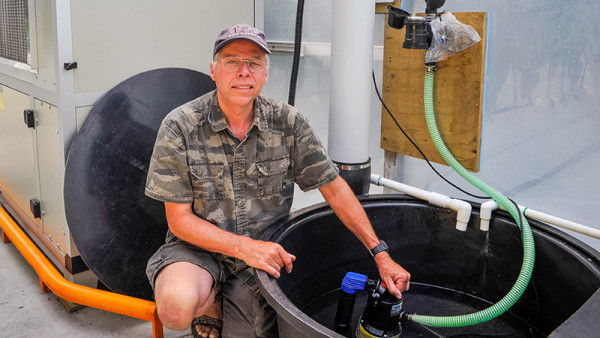Heat on greenhouse growers
18 May 2022
Written by Geoff Lewis
First published in the May 2022 issue of the NZGrower.

Southern Belle owner Frans de Jong with the dehumidifier that he has had installed.
Large commercial greenhouse growers – reliant on heat and carbon dioxide – are searching for viable alternatives to gas and coal, as prices soar and growers seek to reduce their carbon emissions.
Southern Paprika has 26 hectares under glass producing 7000 tonnes of capsicum a year for domestic and export markets. The heat is provided by natural gas and carbon dioxide taken from the heating process, which achieves a 15 percent increase in production.
General manager Blair Morris says their Warkworth operation consumes 275,000 gigajoules of energy annually.
“Some of the big gas producers have stopped investing. Natural gas is our second biggest cost after labour, and our gas price has gone up two to three times. We had one gas supplier for 20 years who told us after 1 April 2022 that they couldn’t supply us.
We are concerned about energy supply and cost. The key problem is New Zealand doesn't have enough renewables for electricity generation. If we get into a loss-making situation, it would be better to close down, repurpose the land and move to an import model.
Morris says Southern Paprika is working with EECA on a transition plan and a number of energy alternatives, all of which are expensive. Biomass from forestry waste is possible but there are uncertainties including the cost of transport and it would not be a 100 percent replacement for gas; maybe 50 percent.
“We are also looking at the capital required. We're big on reducing New Zealand's carbon footprint and the government is doing some good things to support industry, like the GIDI (Government Investment in Decarbonising Industry) fund to help transition to non-carbon alternatives.
“But there is a big concern that the economics of it might kill the industry in the meantime. Once the cost of energy gets beyond a certain point, our business model is gone.”
New Zealand Gourmet production director for protected crops Roelf Schreuder says gas is a big concern and expensive.
“On one of our sites, we went back to coal for the time being as, when combined with transport costs and line fees, it's cheaper than gas. For the future, we are looking at a hybrid model of gas and solar energy. The plan is to set up a solar farm for power supply and make a combination of immersive heat, heat pumps and evacuated pipes.
“The issue will be having no carbon dioxide available for the crop when excluding gas. Liquid carbon dioxide is being imported now Marsden Point has closed, and has become very expensive.”
Electrical heat pumps are among the options to allow glasshouse operators to move away from carbon fuels. However, Neville Stocker, technical director for PGO Horticulture, which specialises in hydroponics for covered crops, says fitting electrical heat pumps to replace gas, coal or diesel fuelled boilers is not only relatively uncommon but likely to be expensive.
“There would be a high cost to change the system, and many properties will not have a power feed of sufficient size to carry the current needed. Greenhouses are often close together, and so whole areas may not have the required infrastructure to power these operations.
All of the extra electricity required will have to come from coal. Where else will it come from? No gas. No more hydro. Coal will have to be it, which has nearly twice the carbon dioxide output of natural gas.
Meanwhile, Firstgas, a natural gas reticulator with around 7000km of gas pipeline in the North Island, is predicting a move to a 20 percent hydrogen and natural gas blend by 2030, and a complete move to hydrogen by 2050.
Hydrogen has nearly three times the calorific (heat) value per quantity (kg) compared with natural gas. However, making hydrogen requires splitting water in a process called electrolysis, and this requires electricity.
Simon Watson, director, NZ Hothouse Ltd, and deputy chair of industry organisation TomatoesNZ, said they had been assured 20 years ago, that if they built there would be gas.
“Now we seem to be running out of gas. We are very, very concerned that we're going to be left in a position where gas is too expensive to use.
“We have the perfect storm. The government is hell-bent on decarbonising the country. This creates huge pressure in the (gas) market. Large greenhouse operations will end up with stranded assets. The government is legislating us out of business and it’s ideologically driven.
“At the moment, we have a (gas) contract we can live with. The question is what happens when we come off that. Options like electricity cost too much. Our whole operation is built around gas so what do we do? Walk away from tens of millions in assets, 300 jobs and 25 percent of the New Zealand tomato industry, or potentially import product from Australia or China, which would be crazy.
“This will be a very big issue over the next couple of years. The idea to decarbonise is good, but they (the government) haven't thought it out.’
